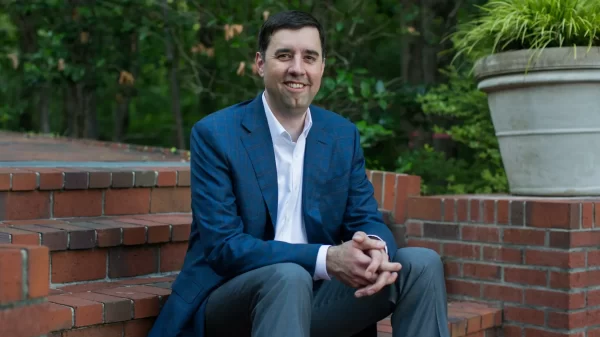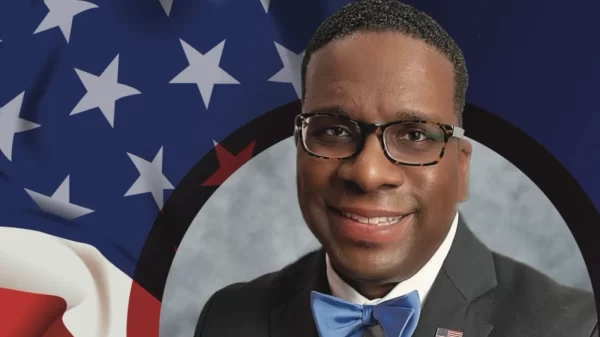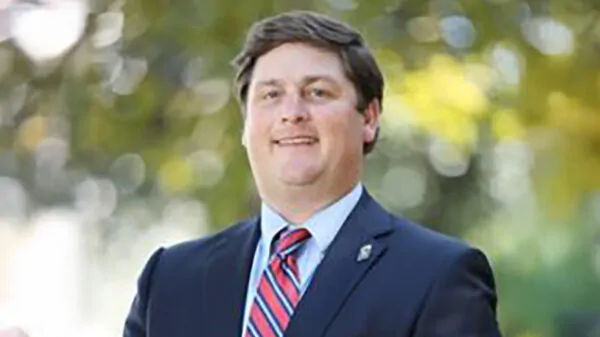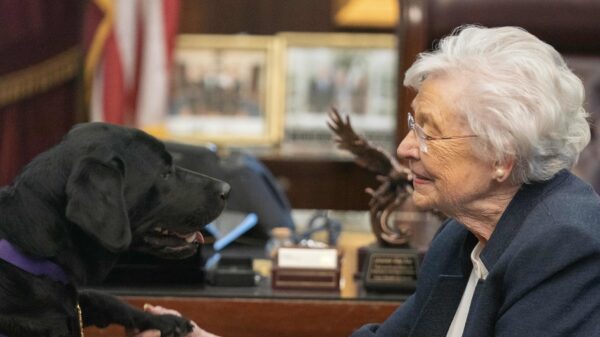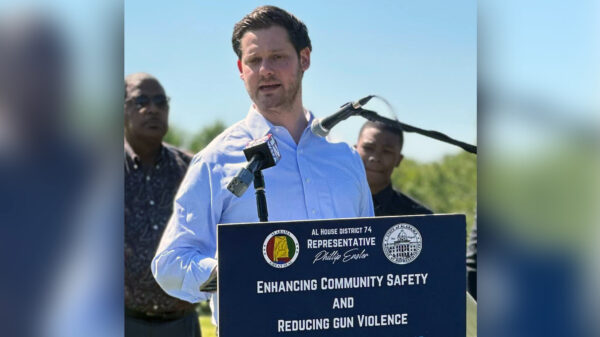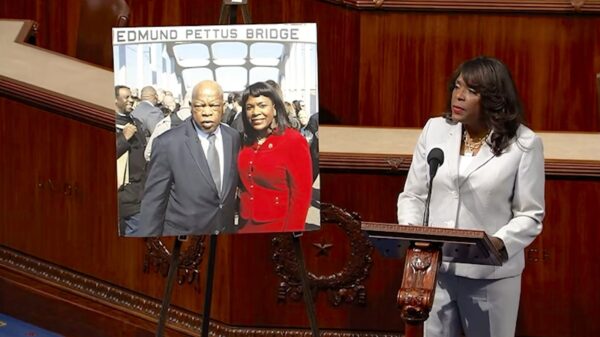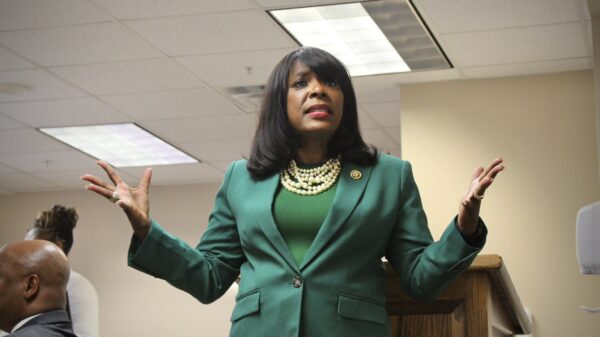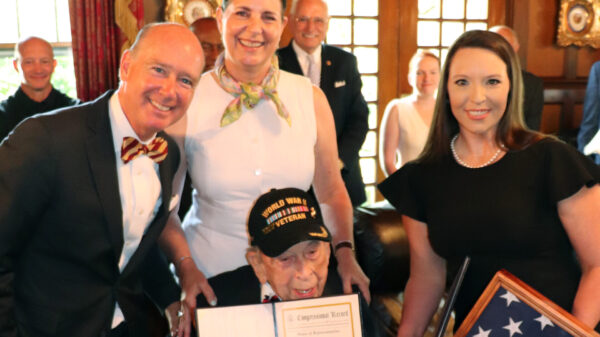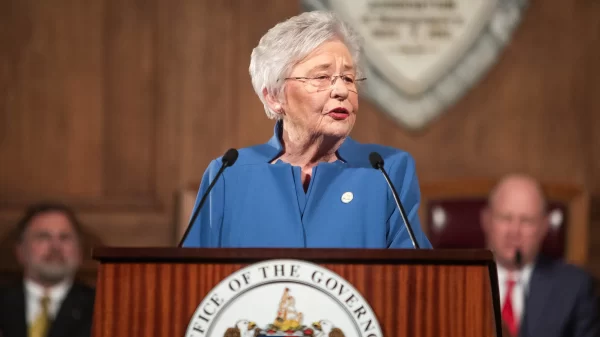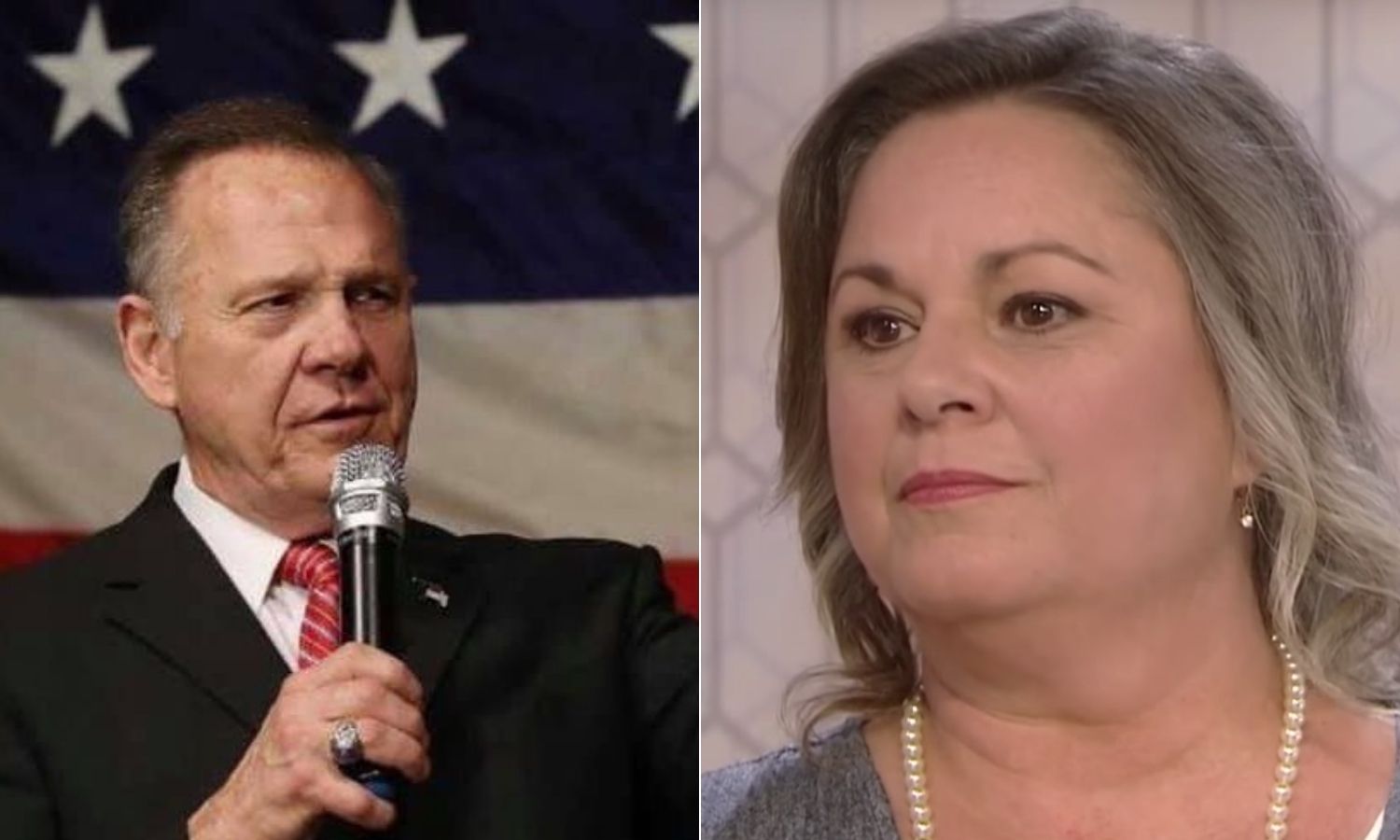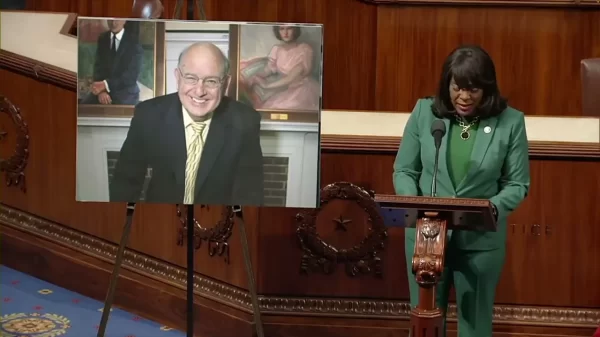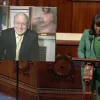Both sides have rested and the jury has entered deliberations in the defamation trial between Roy Moore and his accuser Leigh Corfman.
“This is not about 15 minutes of fame, this is about 40 years of pain,” Jeff Doss, attorney for Corfman, told the jury in a closing argument Tuesday.
“At its base this case is really about who do you believe?” Doss charged the jury. “Do you believe Roy Moore, a powerful politician with a devoted network of followers? … Or do you believe Leigh Corfman, who gained nothing from coming forward other than threats? Who gained nothing other than having her reputation dragged through the mud?”
Moore’s defense argued to the jury that Moore was anything but a powerful politician, pointing to his removal twice from the Alabama Supreme Court.
“He may be one of the most vilified politicians,” said Melissa Isaak, attorney for Moore.
As for Corfman’s reputation, Isaak said Corfman’s attorneys brought no character witnesses to establish that Corfman had a reputation to be “dragged through the mud.”
Former Gadsden attorney testifies to seeing Moore with Corfman at courthouse, but defense questions hearing’s timing
A last minute fact witness changed the course of arguments Tuesday morning when former Gadsden attorney Charlie Boyd testified to seeing Moore with Corfman in the Etowah County Courthouse.
Attorneys for Corfman said they became aware of Boyd as a potential witness after Boyd spoke of the encounter at a lunch meeting with another attorney last Thursday. The defense objected to such a late addition, but Judge John Rochester said he had been flexible throughout the trial in allowing witnesses for both sides.
Boyd testified that he was representing Corfman’s mother, Nancy Wells, at the child custody hearing where Corfman and Wells both testified they first met Moore.
“I came out of the hearing into the hallway and saw Ms. (Nancy) Corfman’s daughter was sitting out there in hallway,” Boyd testified. “(Moore) said ‘She doesn’t need to be in there.’ I said ‘I don’t intend for her to be in there.’ He said he was going to stay out there in the hallway and keep her company.”
Boyd testified that he found that “a little odd” that an assistant district attorney with a busy schedule would be taking the time to sit with a young girl, but was concentrating on his hearing and did not think much more of it. And yet it stuck in his mind all these years later due to his notion that it was odd.
Moore on Monday had again testified that he did not know Corfman at all, and specifically stated that the alleged meeting at the courthouse never happened.
Boyd’s testimony corroborated Corfman’s story and Wells’ testimony, with the defense carving out one key question: was his recollection from February 1979, when Corfman was 14 years old, or was it the summer of 1980, when she was 16?
The defense pointed out that Boyd did not sign the 1979 paperwork identifying Corfman’s attorney, it was an attorney named William Willard. And Boyd testified he remembered the court case being heard in Judge Gerald Swann’s courtroom. But Swann’s signature was on the 1980 paperwork, not on the 1979 forms.
Initially, Boyd testified that his name may not have been on the forms because he joined the case later after Willard had already signed the forms. But upon further questioning and seeing his and Swann’s signature on the 1980 paperwork, he said “it would appear I was incorrect” and that the paperwork was “pretty good proof that what I was talking about happened in 1980 rather than in 1979.”
The defense went a step further and argued that there was no hearing in 1979, stating that the petition to modify custody and consent decree were signed on the same day, which they said typically means the matter did not go to a hearing. They pointed to paperwork in 1980 that specifically set a hearing date, arguing no similar paperwork shows a hearing being set in 1979.
The plaintiffs argued that the 1979 paperwork said the “cause came to be heard” before the judge “together with testimonies of the parties which were heard by court.”
Isaak later objected to that statement in a closing argument, asking Rochester to make sure it was clarified to the jury that the wording is standard in the legal form regardless of whether there is a hearing, but the judge overruled the objection.
Wells took the stand after Boyd and stuck to her testimony that Boyd was her attorney in 1979 regardless of the signature on the paperwork and that she was sure that the meeting with Moore occurred in 1979.
Doss admitted during his closing argument to the confusion caused by Boyd’s testimony as to the timing of the meeting, but asked the jury to focus on what was “unequivocal about Boyd’s testimony.”
“He remembered one thing unequivocally: walking out of the courtroom and seeing Roy Moore sitting on the bench with Leigh Corfman,” Doss said, reminding the jury of Moore’s total denial of knowing Corfman.
Isaak continued to pursue the angle in closing arguments.
“There was no hearing in 1979,” Isaak said. “There was no 14-year-old Leigh Corfman who was picked up. That is a fabrication, that is exactly what that is. The story about her being 14 is completely false.”
A tale of two Roy Moores
Doss painted a picture for the jury of a double life for Moore, describing them as the Gallant Roy Moore and the Gadsden Roy Moore.
A string of character witnesses including family and friends of More’s from Gallant testified Monday to Moore’s character and reputation for honesty and godliness. But Doss told the jury “this case isn’t about that Roy Moore.”
Instead, he argued it was about the Roy Moore who has been accused of preying on young teen girls in Gadsden.
Doss recalled the testimony of women whose statements under oath weaved a pattern of Roy Moore having an interest in “underage” girls, with Moore previously testifying that he considered the term “underage” to mean “under 19.”
Debbie Wesson Gibson recounted Moore visiting her high school to speak in one of her classes, and then asking her out in the parking lot. She was 17 at the time. She agreed and said she dated Moore for 8 to 10 weeks an had nothing but good things to say about Moore’s behavior at the time.
Gloria Thacker Deason testified to meeting Moore where she worked at the Gadsden Mall and beginning dating him when she was 18 and he was 32. She said they dated off and on for several months, and that she visited his house one time. She said he laid down blankets for her, which Corfman’s attorneys connected to Corfman’s testimony that Moore laid down a blanket when he allegedly molested her.
Wendy Miller testified she met Moore at 14 years old while working as a Santa’s helper at the Gadsden Mall and that he called her “cute” and “pretty” at that time. Then when she was 15 or 16, she said he asked her mother for permission to date her, but her mother did not permit him.
Gena Richardson said Moore called her while she was in a high school trigonometry class at age 17 or 18 to ask her out.
Kelly Thorp testified that Moore asked her for her phone number when she was a 17-year-old waitress at Red Lobster, and that she asked him if she knew how old she was. She testified that his response was “I date girls your age all the time.” She also testified that it was an “open secret” in Gadsden among people her age that Moore had a penchant for pursuing girls I high school or around that age.
That was in conflict with the testimony of Moore’s witnesses from Gallant.
Connie Wilkerson, who was 16 years old in 1979, said in Gallant, “everybody knows everything about everybody, sometimes before they know it.”
“Facebook’s got nothing on Gallant,” she said.
“There can’t be two Roy Moores in Gallant, Alabama,” Isaak told the jury. “You can’t live a double life in a tiny little town.
Doss said although the testimony of the other women did not accuse Moore of sexual misconduct or any wrongdoing, the 14-year-old Corfman was “the perfect storm.”
“But for the grace of God, there go I,” Doss said. “We see a mother who stepped in and intervened. We see slightly older young ladies that had a little more experience. With Leigh it was a perfect storm. Her mother doesn’t know what’s going on and this is the escalation that happens.”
Defamation vs. sexual abuse
Early in her closing statement, Isaak told the jury that “this case has turned exactly into what I anticipated in my opening statement: a case as to whether Corfman was sexually abused at the age of 14, as to whether Roy Moore dated teenagers in the 70s and 80s. That’s not what this case is about. You are not tasked with finding out whether Leigh Corfman was molested by Roy Moore or not. Any potential cause of action is long gone.”
Melody Eagan, attorney for Corfman, took issue with that in her closing argument, the final argument of the trial.
“I was surprised to hear Ms. Isaak and Mr. (Julian) McPhillips (attorney for Moore) say that what happened in 1979 doesn’t matter,” Eagan said. “If this case is for defamation you must decide what happened in 1979 because you have to decide whether what Leigh Corfman told The Washington Post was false or what Roy Moore said was false; that is the crux of the case.”
Judge Rochester explained to the jury five basic tenets that must be met to prove defamation:
- a false statement was made
- the statement was defamatory
- it was made knowing the statement was false or with reckless disregard to whether it was false
- it was published to another person
- the statement caused damage
With both parties acting as both plaintiffs and defendants, attorneys for both sides argued each point for defamation of their client while trying to show where the other party’s claims fell short on varying levels.
The defense for Moore argued that his statements were not only true, and therefore exempt, they said the statements were not defamatory. They reminded the jury that Moore never called Corfman a “liar.” Corfman’s counsel conceded that, but said it was irrelevant as the message sent by Moore’s statements amounted to as much.
“Use your common sense,” Doss said. “What was Roy Moore trying to convey to anyone who heard these messages? He was trying to convey that Leigh Corfman is a liar … He claimed Corfman was part of some conspiracy. That she was being false and malicious. A sign of the immorality of our time. He said that was just his opinion. An opinion is ‘I like going to the Biscuits games.’ It’s not this.”
The plaintiffs argued that Moore knew the statements were false, because Moore was there when the alleged incident took place. And they argued it damaged Corfman’s reputation for honesty.
Moore’s attorneys said he had an absolute right to deny Corfman’s allegations and the nothing he stated rose to the level of defamation. They also contend Moore’s statements were true and that he honestly believed them to be true at the time he made them. And they argued Corfman was not damaged, emphasizing that she is not seeking monetary damages.
Isaak pointed to text messages where Corfman referred to the controversy by saying “let the games begin” and other messages that she said undermine the idea that she was suffering.
“Sexual abuse is not a game to real victims,” Isaak said.
Isaak described Corfman’s testimony as “scripted, emotionless prepared very well almost like telling someone else’s story who was not her own.”
“Who did you see emotion from?” She asked the jury. “Roy Moore, Kayla Moore (Moore’s wife), Heather Mayo (Moore’s daughter).”
In McPhillips’ closing argument, he described Corfman’s legal approach as “a lot of smoke and mirrors.”
He called into question an expert witness called by the plaintiffs Tuesday morning that testified to the date of a Polaroid photo depicting Moore’s Gallant home. Moore had testified that the photo represented the house as it was in 1979, which he had earlier testified was “constantly changing” even on a weekly basis. The photo was a large subject of discussion during Monday’s testimony. The expert witness, Tracy Storer, testified that the numbers on the bottom of the picture mean the film itself was manufactured by Polaroid in January 1980.
Despite that fact, McPhillips said that does not contradict Moore’s testimony that the photo showed the house as it was a few months prior.
He also picked up his argument from his opening statement that “this was all just one huge enormous ego trip” for Corfman.
“That’s what all this is about; this lawsuit is about that too, to keep her name in the press,” McPhillips said.
McPhillips told the jury that Corfman’s allegation was “child’s play” compared to the allegations against two former Presidents.
Eagan got emotional when rebutting McPhillips’ statement in her closing argument.
“I was surprised and horrified of Mr. McPhillips’ description for a 32-year-old man touching a14 year-old-girl, calling that ‘child’s play,’” Eagan said. “As a woman, as a parent of a 14-year-old child, I am horrified that that is ‘child’s play.’ I have to bite my tongue. I am telling you that is horrible and also I would say this: I thought it was Roy Moore’s position that he’s never seen Leigh Corfman. Why are we talking about whether that is ‘child’s play?’”
McPhillips said “certain women are drawn to powerful political figures” and that Corfman “must have been and is today.” He also again brought up Corfman reading romance novels as a teen and that it contributed to a “vivid imagination” that conjured up the allegations against Moore.
McPhillips also referenced that Corfman’s attorneys are working pro bono and that “we don’t know what that’s about,” allowing an opportunity for Eagan to rebut in her final argument.
“We’re not getting paid a penny for being here,” Eagan said. “(McPhillips) said ‘I don’t know what that’s about.’ I’ll tell you what it is about: we are proud to represent Leigh Corman. We believe in her and we believe in justice and we believe in truth. That, ladies and gentleman, is why we are here.”
McPhillips also told the jury that Corfman “opened the door” to the controversy by publishing her story and filing a defamation lawsuit. Isaak had stated “Roy Moore did not start this; he was blindsided like a deer in the headlights.”
“Roy Moore started this 40-something years ago when he inappropriately preyed on Leigh Corfman,” Eagan countered.
Eagan said that, “faced with overwhelming evidence,” Moore’s counsel had to resort to “lawyer tricks” to defend Moore, referring to their claims that Moore merely denied the allegations or that they were his opinions.
Eagan concluded her argument by stating that Moore believed he was above the law and asked the jury to hold him to the “same standards that apply to all of us.”
“Mr. Moore seems to think the laws of our country do not apply to him,” Eagan said. “We’ve heard about the Ten Commandments. I teach first and second graders in Sunday school each and every Sunday. I teach them about the Ten Commandments. Mr. Moore has carried a theme here that he is not bound by the law. He writes the child abuse law in 1977 and what does he do with Leigh Corfman in 1979? Judge Myron Thompson orders him to remove the Ten Commandments and he doesn’t obey. After being reelected to Chief Justice he is suspended from the court for violating ethics rules. He didn’t think he was accountable to the law.”
The jury began deliberating around 3:45 p.m. on Tuesday and after approximately an hour of deliberation asked for the deliberation to be continued to Wednesday to view video evidence and to “not be rushed” on its decision.
The jury foreman told Judge Rochester that he believes a verdict could be reached Wednesday.
The jury can deliver verdicts for either Corman or Moore, or find in favor of both parties or neither party.

